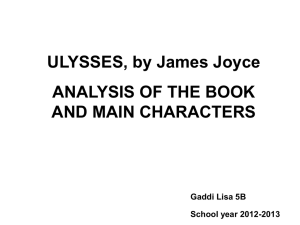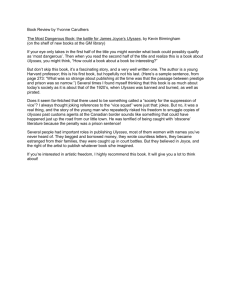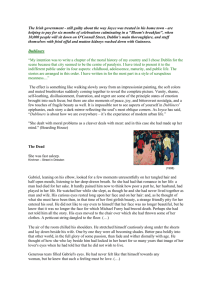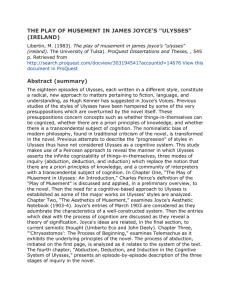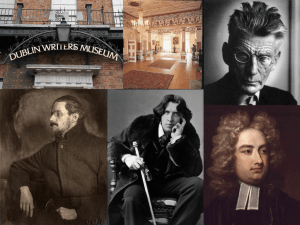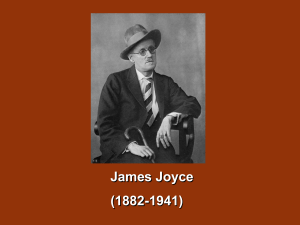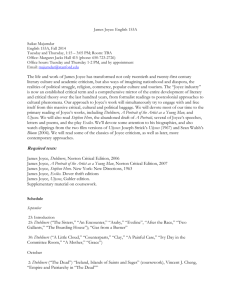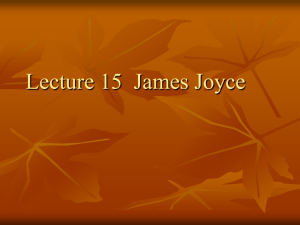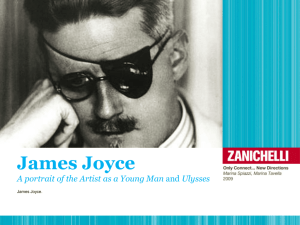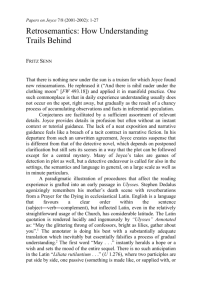Notes on Ulysses
advertisement
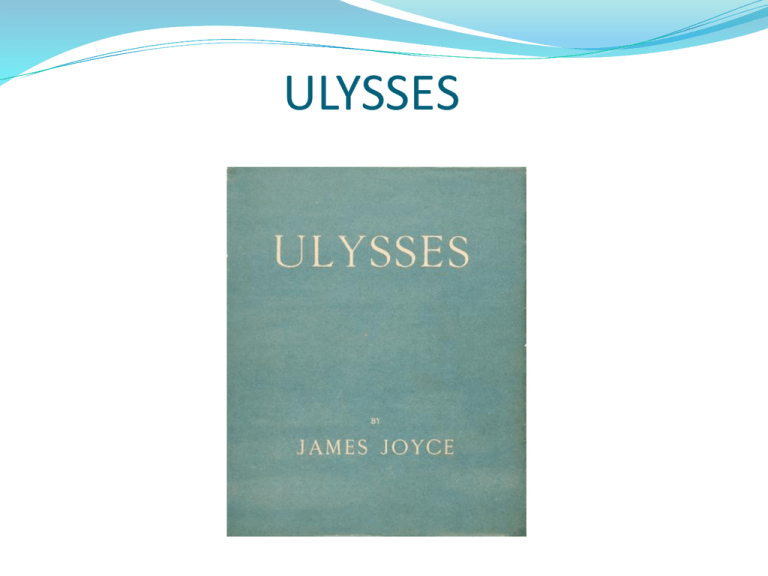
ULYSSES Content T.S.ELIOT – «ULYSSES, ORDER AND MYTH» THE USE OF MYTH – JOYCE AND HOMER CHARACTERS SETTING AND STRUCTURE PLOT SUMMARY NARRATIVE TECHNIQUES THEMES T. S. ELIOT: Ulysses, Order and Myth Eliot thought that the classical tradition was fundamental, he was the first to praise this device of imposing a myth on a contemporary experience. “It is a way of controlling, of giving a shape and a significance to the immense panorama of futility and anarchy which is contemporary history.” “Mr Joyce’s parallel use of the Odyssey has a great importance. It has the importance of a scientific discovery.” “Instead of narrative method we may now use the mythical method.” Basic Principles Any moment may represent the whole life of an individual - Everything is worth writing about, everything is important Traditional novel (Defoe, Richardson etc.) followed the characters from birth to death, now we get inside the consciousness of the characters. • Consciousness preserves memories of the past, impressions of the present, anticipations of the future Sometimes, we experience a sort of revelation (epiphany = sth apparently unimportant that turns out to be crucial in our life) THE USE OF MYTH– JOYCE AND HOMER Joyce based the framework of his novel on the structure of one of the greatest and most influential works in world literature, The Odyssey, by Homer. In this epic poem Homer presented the journey of life as a heroic adventure. The protagonist of this epic tale, Odysseus (Roman name, Ulysses), encounters many perils–including giants, angry gods, and monsters–during his voyage home to Ithaca, Greece, after the Trojan War. In Joyce's 20th Century novel, the author also depicts life as a journey, in imitation of Homer. But Joyce’s Ulysses is different and his activities parallel in some way the adventures of Homer's Ulysses. The Odyssey was used as a parallel text, creating correspondences between the Homeric poem and the novel It was meant to be a sort of guideline to organise the plot and not to get lost in the modern world and in the people’s mind This enabled Joyce to give to his book a symbolic and universal dimension suggesting that his character (L.Bloom) is a modern Ulysses, the man who can stand for humanity, a sort of modern Everyman and the setting (Dublin) becomes symbolic of the whole world and to his characters who come to represent an eternal mankind CHARACTERS Stephen Dedalus A young Latin teacher and aspiring writer Already the protagonist of A Portrait of the Artist as a Young Man He represents: the artist Joyce’s alter ego Joyce’s fictional projection of himself Stephen-Joyce thinks of himself as a victim of incomprehension in his own land He has rejected the Catholic faith of his family He decides to leave Ireland to follow art = Also Joyce rejected Irish life, condamned Irish provincialism (paralysis), wanted to find out his own identity choosing a voluntary exile becoming the most cosmopolitan of Irish writers, open to the influence of other cultures and intellectual traditions Leopold Bloom • A middle-aged man of Jewish origins • He has rejected the Jewish faith of his father and feels • • • guilty He feels lonely and powerless because of his wife’s infidelity, his father’s suicide and his son’s death He represents the citizen, the middle-class man He wanders around Dublin as Ulysses wanders around the Mediterranean but his adventures consists of getting breakfast, feeding his cat, going to a funeral, doing his job, visiting pubs or restaurants, and thinking about his unfaithful wife. Molly Bloom Normal middle-class person Good-looking, sensual woman in her maturity She is chronically unfaithful to her husband She is ironically alluded to as Penelope SETTING AND STRUCTURE Set in Dublin on a single day - 16 June 1904 18 episodes divided into three sections: 1. (Episodes 1 – 3) Telemachia (adventures of Stephen-Telemachus) dominated by the figure of the Son This section presents Stephen's life on a typical day in which he finds Dublin depressing. He is pessimistic about realizing his dream to become a published author. 2. (Episodes 4 – 15) Odyssey (adventures of Leopold-Ulysses) dominated by the figure of the Father This section presents his voyage through an ordinary day in Dublin. Joyce describes in detail both Dublin and Bloom, presenting his freeflowing thoughts–many of them either about his unfaithful wife, Molly, or other women. 3. (Episodes 16 – 18) Nostos (Bloom returns home to Molly-Penelope) Dedalus goes to Bloom's home and talks with him for several hours. The novel ends with a chapter on Molly. It consists of more than 30 pages occupied by sentences (24.195 words) with no punctuation except for the period at the end of the novel. Each episode corresponds to a section of the Odyssey 1. Telemachus 2. Nestor 3. Proteus 4. Calypso 5. Lotus Eaters 6. Hades 7. Aeolus 8. Lestrygonians 9. Scylla and Charybdis 10. Wandering Rocks 11. Sirens 12. Cyclops 13. Nausicaa 14. Oxen of the Sun 15. Circe 16. Eumaeus 17. Ithaca 18. Penelope PLOT SUMMARY -The following summary presents only the highlights of Joyce's long, complicated novel. The book is too complex to include all the significant details. -Leopold Bloom leaves home at 8 o’clock on Thursday morning and returns at 2 at night -In his wanderings he meets Stephen Dedalus, an artist -Few incidents occur. Stephen quarrels with some friends and leaves the place he lived in -He wanders the streets of Dublin in search for a father and a home -Bloom buys breakfast, attends a funeral, goes to his office, visits the National Library, meets various people -Molly commits adultery in the afternoon -Bloom comes across Stephen several times during the day; he comes to know Stephen has quarrelled with his father and tries to help him. At midnight he rescues him from a brawl in a brothel and “adopts” him by taking him home and offering him a shelter -They talk about various subjects. When Stephen leaves Leopold goes to bed -Molly asks him questions about the day -He asks her to serve him breakfast in bed the following day and falls asleep -The book ends with Molly’s meditations as she lies half asleep in bed STYLE AND NARRATIVE TECHNIQUES Ulysses is an experimental novel in the modenist tradition. New experimental techniques William James, Principles of Psychology (1890) Consciousness “a river or a stream are metaphors by which it is most naturally described... let us agree to call it the stream of thought, or consciousness or of subjective life” Stream-of-consciousness fiction is concerned with the area which is normally beyond communication: Speech level vs Pre-speech level The novelist has to explore: what the mental process is started by and what it consists of (memories, dreams, impressions, sensations, intuitions) how it works (symbols, association of ideas, juxtaposition of images) In stream of consciousness, a term coined by American psychologist William James (1842-1910), an author portrays a character’s continuing “stream” of thoughts as they occur, regardless of whether they make sense or whether the next thought in a sequence relates to the previous thought. Interior monologue: the literary instrument used to translate that phenomenon into words - Direct interior monologue - in first person - sudden shifts from thought to thought - no apparent connection of subject, verb etc. - no evident intervention of the ordering mind of a narrator - direct access to the mind of the character - often no punctuation - This exposes a character’s memories, fantasies, apprehensions, ambitions, rational and irrational ideas, and so on. In the last chapter of the novel, Joyce omits punctuation entirely in order to reproduce the uninterrupted flow of thoughts. Joyce also uses numerous sentences and phrases from Latin, French, German, Spanish, Russian (transliterated), Italian, and other languages. In addition, he uses refined language, vulgar language, slang and even coined new words THEMES Every human goes on a journey, just as the mythical Odysseus (Roman name, Ulysses) did in his heroic adventures in Homer’s Odyssey. Life as journey But in the real life of modern man, this journey is generally uneventful, as in Joyce's Ulysses, rather than heroic. Characters as heroes or anti-heroes Classical heroes were strong, brave, corageous, loyal, respected and often of high rank (Queens or Kings) Leopold Bloom does not share any of these features, the idea of L.B. as an epic hero is laughable, he represents the average modern man, a 20th century hero He is able to face everyday problems with his rich humanity in spite of his sense of loneliness and diversity His is a modern battle against the lack of values, the emptiness and futility of our society The plot has been interpreted as illustrating the main theme of a father looking for a son and a son looking for a father Stephen has abandoned his Bloom has an adolescent choleric, alcoholic father daughter; his only son died 11 days after birth He can’t live with his family any more Stephen: a surrogate for his missing fatherhood He is momentarily in search of a paternal figure They are representatives of two opposite ways of life: Leopold - the citizen characterized by patience, a sound attitude to life, tolerance, intellectual curiosity; a reliable person the average modern man, an anti-hero, the modern Ulysses most episodes are seen from his point of view or directly through his practical mind Stephen - the artist who desires freedom above all like Daedalus, he is a rebel, he struggles against authority, his family, he looks for ideals and his own identity he also has the defects of the intellectual: he is selfish, self-involved, not interested in the rest of the world He thinks in highly philosophical terms The novel presents many other themes, or sub-themes: Religion Guilt Infidelity and sexual temptation Anti-semitism
